Physio Dr.K.Dhatchina Moorthy BPT.,D.Acu.,DTTM. ,
*Chief Physiotherapist *Acupuncturist Regn.No:74981405
Call: 88705 91758
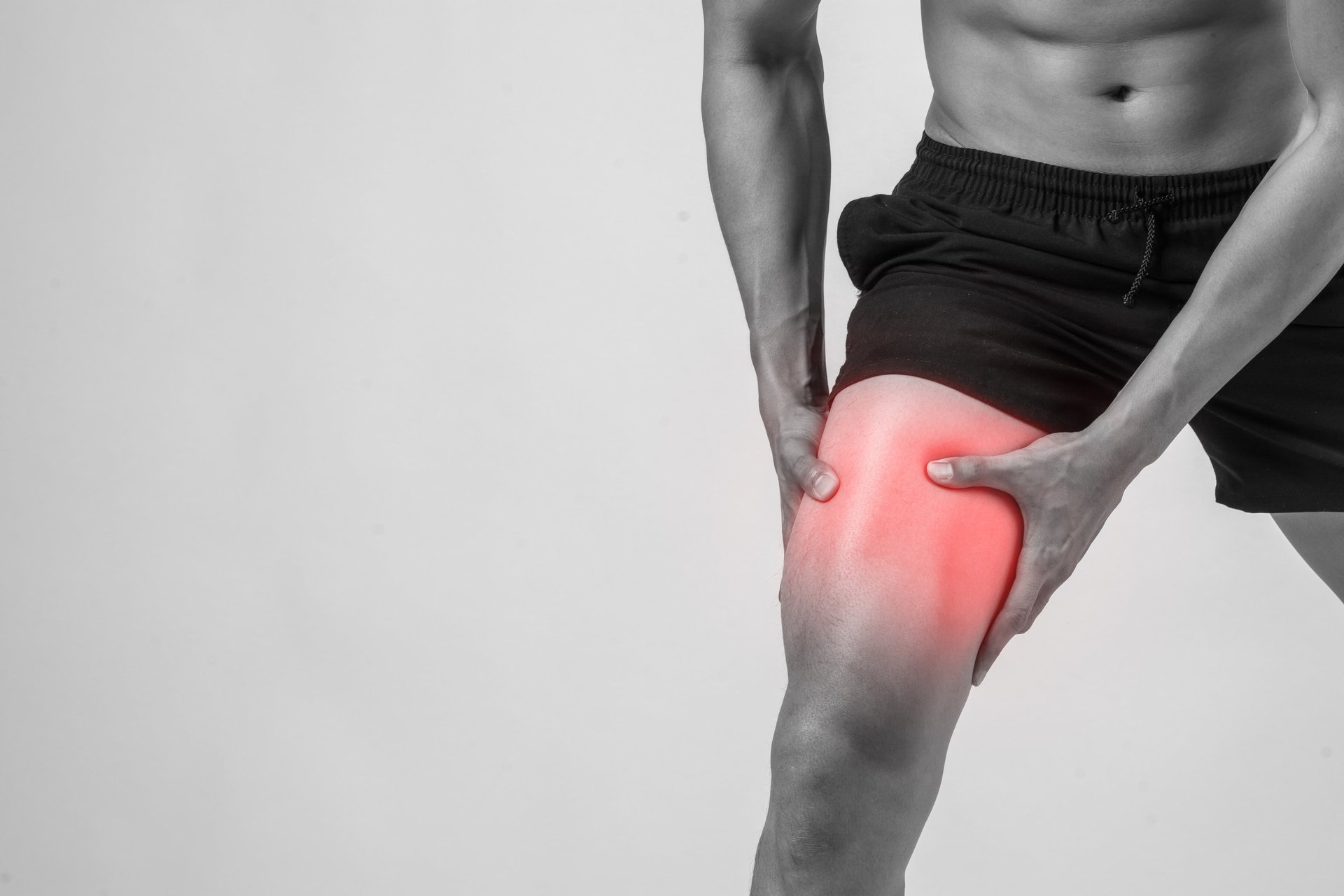
Conditions treated by physiotherapy
Acute & Chronic Pain
Physiotherapy plays a crucial role in both acute and chronic pain management, offering a comprehensive approach to pain relief and functional restoration. For acute pain, physiotherapy focuses on reducing inflammation, promoting healing, and restoring movement, often utilizing manual therapy and modalities like electrotherapy. In chronic pain, physiotherapy aims to improve mobility, strength, and functional ability, while also addressing psychological factors and lifestyle modifications.
Acute Pain Physiotherapy:
Assessment:
Physiotherapists assess the nature, severity, and cause of acute pain to develop a personalized treatment plan.
Modalities:
Various modalities like heat, cold, electrotherapy (e.g., TENS), and manual therapy (massage, joint mobilization) may be used to manage pain and inflammation.
Exercise Therapy:
Specific exercises are prescribed to improve range of motion, strengthen muscles, and promote healing.
Education and Advice:
Patients receive guidance on proper body mechanics, pain management strategies, and activity modifications to prevent further injury.
Chronic Pain Physiotherapy:
Assessment:
Physiotherapists evaluate the patient's pain history, functional limitations, and psychological factors to develop a comprehensive treatment plan.
Exercise Therapy:
Exercise is a cornerstone of chronic pain management, helping to improve strength, endurance, and overall fitness.
Manual Therapy:
Gentle manual techniques like massage, joint mobilization, and trigger point release can help reduce pain and improve mobility.
Education and Self-Management:
Physiotherapists provide education on pain mechanisms, coping strategies, and lifestyle modifications to empower patients to manage their pain.
Psychological Support:
Chronic pain can significantly impact mental health, and physiotherapy may involve incorporating psychological techniques like CBT or mindfulness to help patients cope with pain and improve their quality of life.
Key Differences:
Focus:
Acute physiotherapy focuses on healing and restoring function after an injury or specific event, while chronic physiotherapy addresses long-term pain and its impact on daily life.
Treatment Goals:
Acute physiotherapy aims to reduce pain and inflammation and promote healing, while chronic physiotherapy focuses on improving function, managing pain, and enhancing quality of life.
Treatment Approaches:
Acute pain may involve a more active, hands-on approach with a focus on immediate pain relief, while chronic pain treatment often incorporates exercise, self-management strategies, and psychological support.
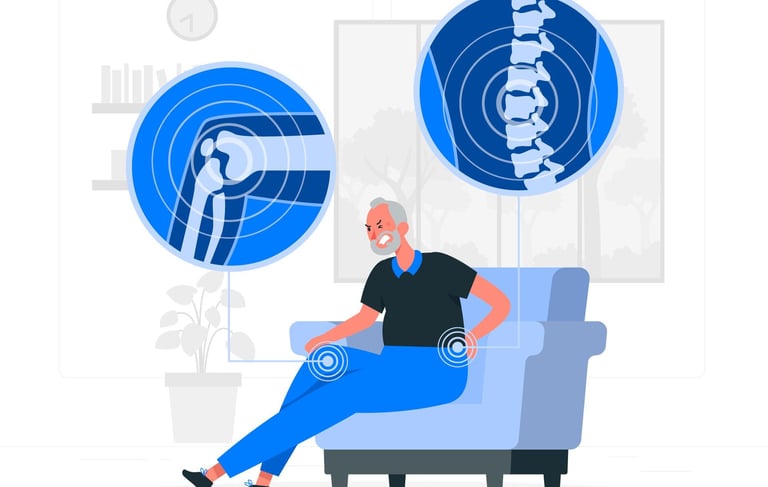

Back and Neck Pain
Neck and back pain are very common conditions that can significantly impact daily life. These pains often result from issues with the musculoskeletal system, including the spine, muscles, and ligaments. The exact cause of neck and back pain can vary, and it's often difficult to pinpoint the source.
Causes of Neck and Back Pain:
Muscle Strain/Sprain:
Overexertion or improper lifting can lead to strain or sprain of muscles and ligaments in the back and neck.
Disc Problems:
Herniated or bulging discs, which can put pressure on nerves, are a common cause of back and neck pain.
Degenerative Conditions:
Conditions like arthritis and spinal stenosis (narrowing of the spinal canal) can cause pain as the spine ages.
Poor Posture:
Maintaining poor posture can put stress on the spine and lead to both neck and back pain.
Injuries:
Trauma, accidents, and whiplash can cause injuries to the neck and back.
Other Conditions:
Conditions like meningitis, certain cancers, and arthritis can also cause pain in the neck and back.
Mental Stress:
Stress can lead to muscle tension in the neck and back, contributing to pain.
Symptoms:
Pain:
The most common symptom is pain, which can range from mild to severe.
Stiffness:
Pain may be accompanied by stiffness, making it difficult to move the neck or back.
Numbness or Tingling:
In some cases, nerve compression can cause numbness or tingling sensations in the arms or legs.
Radiating Pain:
Pain can radiate down the arms or legs, depending on the source of the pain.
Treatment and Management:
Rest: Resting the affected area can help reduce inflammation and pain.
Heat or Cold Therapy: Applying heat or cold packs can help reduce pain and inflammation.
Over-the-Counter Medications: Pain relievers like ibuprofen (Advil, Motrin) and acetaminophen (Tylenol) can help manage pain.
Stretching and Exercise: Gentle stretching and exercise can help improve flexibility and reduce muscle stiffness.
Physical Therapy: A physical therapist can develop a customized exercise program to strengthen muscles and improve posture.
Massage Therapy: Massage can help relax tense muscles and reduce pain.
Proper Posture: Maintaining proper posture when sitting, standing, and lifting can help prevent further pain.
When to Seek Medical Attention:
If the pain is severe or persistent.
If you experience numbness, tingling, or weakness in your arms or legs.
If you have a fever, chills, or other signs of infection.
If you have a history of cancer or other serious illnesses.
If you suspect you have a serious injury, such as a spinal fracture.
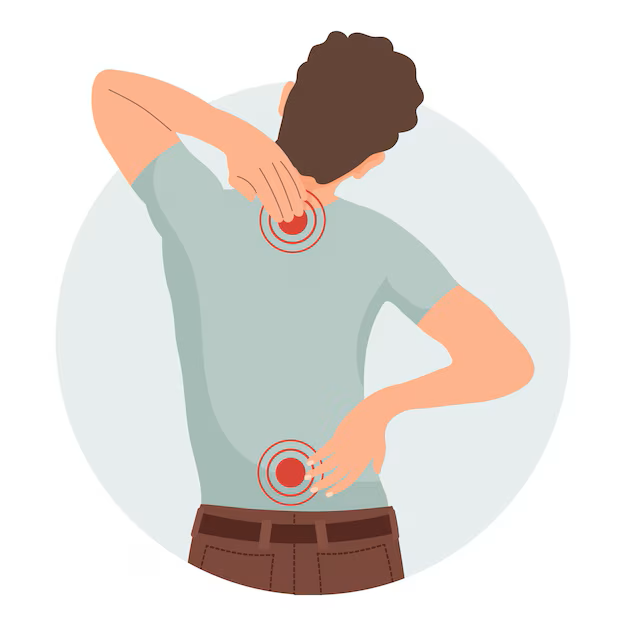

Shoulder/Elbow/Wrist/Hip/Knee Pain
Physiotherapy for shoulder, knee, and hip pain aims to reduce pain, improve joint function, and strengthen surrounding muscles through a combination of exercises, manual therapy, and other modalities. This approach can be tailored to the individual's specific condition and needs.
Shoulder Pain:
Exercises:
Shoulder rotations, pendulum exercises, wall slides, and stretches to improve flexibility and range of motion.
Manual Therapy:
Soft tissue massage, joint mobilization, and nerve mobilization to address muscle stiffness and joint restrictions.
Other Modalities:
Heat or cold packs, ultrasound, and electrical stimulation (TENS) for pain relief and muscle relaxation.
Knee Pain:
Exercises:
Knee flexion, extension, hamstring curls, and quad strengthening exercises to improve strength and reduce pain.
Manual Therapy:
Joint mobilization, soft tissue massage, and nerve mobilization to address pain and stiffness.
Other Modalities:
Heat or cold packs, ultrasound, and electrical stimulation (TENS) for pain relief and muscle relaxation.
Functional Training:
Exercises like squats, lunges, and single-leg balance activities to improve functional movement and stability.
Hip Pain:
Exercises:
Hip flexion, extension, abduction, and adduction exercises, fire hydrant exercises, and bridge exercises to improve strength, mobility, and stability.
Manual Therapy:
Joint mobilization, soft tissue massage, and nerve mobilization to address muscle stiffness and joint restrictions.
Other Modalities:
Heat or cold packs, ultrasound, and electrical stimulation (TENS) for pain relief and muscle relaxation.
Functional Training:
Exercises like squats, lunges, and single-leg balance activities to improve functional movement and stability.
Important Considerations:
Individualized Treatment:
Physiotherapy plans should be tailored to the individual's specific condition, goals, and limitations.
Pain Management:
Pain management techniques, such as heat or cold therapy, can be used to alleviate pain and allow for easier movement.
Progressive Approach:
Exercises should be started slowly and gradually progressed as tolerated to avoid exacerbating pain.
Lifestyle Modifications:
Addressing factors that contribute to pain, such as poor posture, improper lifting techniques, and lack of activity, can be helpful.
Home Exercises:
Patients are often given a home exercise program to reinforce the physiotherapy session and promote long-term benefits.
Manual Therapy:
Techniques like massage, joint mobilization, and nerve mobilization can help to improve pain and reduce stiffness.
In summary, physiotherapy for shoulder, knee, and hip pain involves a comprehensive approach that includes exercise, manual therapy, and other modalities to reduce pain, improve joint function, and strengthen muscles. The treatment plan should be individualized and progressive, with a focus on addressing the underlying cause of the pain and promoting long-term functional improvements.
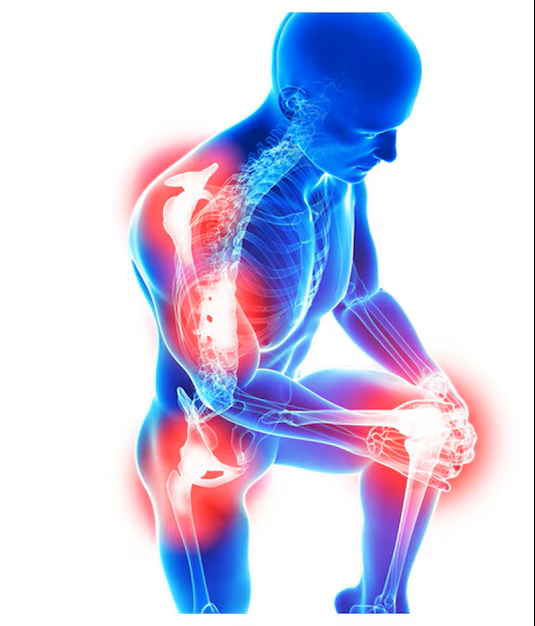

Headache/Migraine
Physiotherapy can be a helpful complementary approach to managing migraines, focusing on addressing musculoskeletal issues, improving posture, and promoting relaxation. It may involve manual therapy, exercise, and education to reduce migraine frequency and intensity.
Elaboration:
Manual Therapy:
Physiotherapists may use manual techniques like massage, trigger point release, and joint mobilization to address muscle tension and stiffness in the neck and shoulders, which can be contributing factors to migraines.
Exercise and Posture:
Specific exercises, including stretching and strengthening exercises for the neck and upper back, can help improve posture and reduce strain on the cervical spine, potentially alleviating migraine triggers.
Relaxation and Stress Reduction:
Physiotherapists can teach relaxation techniques, like deep breathing exercises, and stress management strategies, which are important for managing migraine symptoms.
Education:
A physiotherapist can educate individuals on migraine triggers, lifestyle factors, and self-management strategies to help them better understand and manage their migraines.
Individualized Approach:
Physiotherapy treatment for migraines should be individualized, as different people may have different underlying issues contributing to their headaches. For example, someone with migraine triggered by reading might need a different approach than someone with migraine triggered by neck and shoulder movements.
Potential for Vestibular Migraines:
Physiotherapy, including vestibular rehabilitation exercises, can also be beneficial for managing vestibular migraines, which involve dizziness, vertigo, and balance disturbances.
Complementary Therapy:
Physiotherapy is often used as a complementary therapy to pharmacological treatment, rather than a standalone treatment for migraine.
Examples of exercises:
Shoulder blade squeezes, maintaining an upright spine while squeezing shoulder blades together, and moving them down the back like putting them in back pockets.
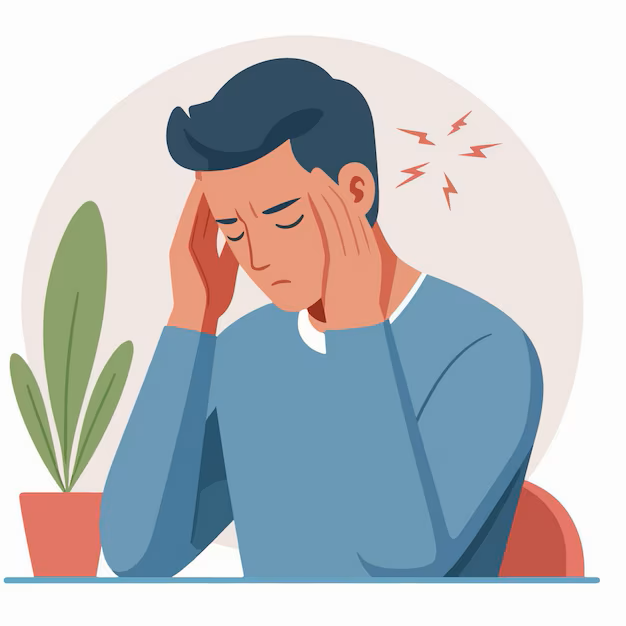

Muscle Pain/Myalgia/Fibromyalgia
Not just pleasant on the outside, our Pleasantview Gem Inn properties are especially popular among families. With underground parking and floor-to-ceiling windows, there's no shortage of natural light or space.


Post Surgical Rehabilitation (Post-op)
Not just pleasant on the outside, our Pleasantview Gem Inn properties are especially popular among families. With underground parking and floor-to-ceiling windows, there's no shortage of natural light or space.


Stroke Rehabilitation
Not just pleasant on the outside, our Pleasantview Gem Inn properties are especially popular among families. With underground parking and floor-to-ceiling windows, there's no shortage of natural light or space.


Head & Spine Injury Rehabilitation
Not just pleasant on the outside, our Pleasantview Gem Inn properties are especially popular among families. With underground parking and floor-to-ceiling windows, there's no shortage of natural light or space.


Balance & Gait Training
Not just pleasant on the outside, our Pleasantview Gem Inn properties are especially popular among families. With underground parking and floor-to-ceiling windows, there's no shortage of natural light or space.


Home Physiotherapy Services
Not just pleasant on the outside, our Pleasantview Gem Inn properties are especially popular among families. With underground parking and floor-to-ceiling windows, there's no shortage of natural light or space.


Vestibular Physiotherapy
Vestibular physiotherapy, also known as vestibular rehabilitation therapy, is a specialized form of physical therapy that addresses vestibular disorders, which cause dizziness, vertigo, and balance issues. It aims to improve balance, reduce dizziness, and enhance overall function by using targeted exercises and strategies.
Benefits of Vestibular Physiotherapy:
Improved Balance:
Vestibular rehabilitation can significantly improve balance and reduce the risk of falls.
Reduced Dizziness:
It can help reduce the frequency and severity of dizziness episodes.
Enhanced Quality of Life:
By improving balance and reducing dizziness, vestibular physiotherapy can help individuals lead more active and fulfilling lives.
Increased Confidence:
Individuals may regain confidence in their ability to move and perform everyday tasks.



